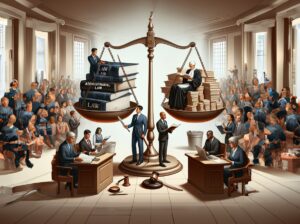Joking about politics
On November 3rd, the president of the United States spoke at the Hotel Lowry in St. Paul, Minnesota, in what was billed repeatedly as a bi-partisan address. The president ridiculed reactionaries in Congress who he claimed represented the wealthy and the powerful, and whose “theory seems to be that if these groups are prosperous, they ... Joking about politics
Goodbye my friend
It is impossible to put into words the loss I feel today. Larry was a beloved mentor and friend, he was the first person I turned to shoot down my random musings, and he always surprised me with the facility of his mind and the passion he had for ideas. Larry was an iconoclast, and ... Goodbye my friend
Todd Henderson on Project Behavior: What the Battle is Really About
Lying in bed for the past day with a stomach bug, I’ve enjoyed reading the contributions of my friends and colleagues. Perhaps the wisest course would be to, like Leonardo DiCaprio’s character pretending to be a doctor in “Catch Me If You Can,” say “I concur” and slip back under the covers. My general views ... Todd Henderson on Project Behavior: What the Battle is Really About
Time to go
This episode has had a profoundly negative impact on me. To be sure, I deserved and even welcomed criticism of my remarks. But the firestorm this created was completely unanticipated. Lies and misinformation, like that our family earns $450,000, spread uncontrollably. One of the perpetrators, Henry Blodget, has graciously agreed to correct this mistake. (Thank ... Time to go
I’m sorry
The posts that generated an unintended blogocane have been deleted. I stand by the posts, the facts in them, and the points they were making. The reason I took the very unusual step of deleting them is because my wife, who did not approve of my original post and disagrees vehemently with my opinion, did ... I’m sorry
Sometimes words escape me
In a reply to a comment on my post about the proposed burning of the Koran, I condescendingly lectured someone about their claim that the First Amendment might not protect Koran burning because it was akin to shouting “fire” in a crowded theater. Turns out, the commentator has company on the Supreme Court. In an ... Sometimes words escape me
Thoughts on the non-mosque mosque
I’ve resisted posting about this, since everything that could be said has been said. But I can’t abide the views expressed everywhere, even among my friends and colleagues, that I’m a bigot or ignorant or anti-Muslim or xenophobic for thinking the proposed Park51 project (nee Cordoba House) should be voluntarily moved by its backers.
Union-boss compensation
There are hundreds and hundreds of academic articles in law, finance, economics, business, and other social sciences discussing the issue of executive compensation broadly and down to the smallest detail. There are none — actually, one working paper in draft form on one issue — that I can find on the issue of how much ... Union-boss compensation
Paul Krugman spouting nonsense
In this morning’s New York Times, Professor Paul Krugman laments the state of America, and, as a remedy, proposes . . . surprise! . . . more government spending. He writes: “When we save a schoolteacher’s job, that unambiguously aids employment; when we give millionaires more money instead, there’s a good chance that most of ... Paul Krugman spouting nonsense
The Obama tax increases
The biggest and most important issue for the next few months won’t be immigration, the New Black Panthers, or even the war in Afghanistan. Huge tax increases are headed our way, and it raises tough questions. On the one hand, signaling we are serious about deficits is likely a good thing. But, since politicians haven’t ... The Obama tax increases
The government reward for doing a bad job
In the world of competitive markets, if one does a bad job, the typical result is less resources, less power, and more oversight by interested parties. If a firm makes a bad product, there will be fewer profits, lost market share, and additional attention from Consumer Reports, plaintiffs’ lawyers, and regulators. In the world of ... The government reward for doing a bad job
The shareholder wealth maximization myth
In a recent speech at the Netroots Nation, Senator Al Franken tried to frighten the crowd by trotting out the corporate bogeyman that greedily makes decisions without regard to anything other than profit. Franken told them: “it is literally malfeasance for a corporation not to do everything it legally can to maximize its profits.” Individuals ... The shareholder wealth maximization myth





